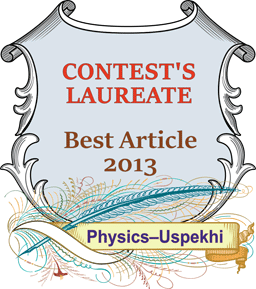 |
RSS feeds |
|
|||||
| Issue 12, 2025 |
|
||||||
|
|
|
||||||
Issues/2013/May |
← → |
| Reviews of topical problems |
Relativistic mirrors in plasmas — novel results and perspectives
a Kansai Photon Science Institute, Japan Atomic Energy Agency, 8-1-7 Umemidai, Kyoto, Kizugawa-shi, 619-0215, Japan
b Prokhorov General Physics Institute of the Russian Academy of Sciences, ul. Vavilova 38, Moscow, 119991, Russian Federation
c S I Vavilov State Optical Institute, Birzhevaya liniya 12, St. Petersburg, 199034, Russian Federation
d ITMO University, Kronverksky Pr. 49, bldg. A, St. Petersburg, 197101, Russian Federation
e Ioffe Institute, ul. Polytekhnicheskaya 26, St. Petersburg, 194021, Russian Federation

In plasmas, the relativistic flying mirrors are thin and dense electron or electron—ion layers accelerated by the high intensity electromagnetic waves up to velocity close to the speed of light in vacuum; in nonlinear-media the refraction index modulations are induced by a strong electromagnetic wave. The reflection of the electromagnetic wave at the relativistic mirror results in its energy and frequency change. In the counter-propagation configuration the frequency of the reflected wave is multiplied by the factor proportional to the gamma-factor squared. This scientific area promises the development of the sources of ultrashort
|
PACS: 52.35.Mw, 52.38.Ph, 52.59.Ye ()
DOI: URL: https://ufn.ru/en/articles/2013/5/a/  000322890700001 000322890700001  2013PhyU...56..429B 2013PhyU...56..429B Citation: Bulanov S V, Esirkepov T Zh, Kando M, Pirozhkov A S, Rosanov N N "Relativistic mirrors in plasmas — novel results and perspectives" Phys. Usp. 56 429–464 (2013) Received: 17th, July 2012, accepted: 27th, July 2012 Оригинал: Буланов С В, Есиркепов Т Ж, Кандо М, Пирожков А С, Розанов Н Н «Релятивистские зеркала в плазме — новые результаты и перспективы» УФН 183 449–486 (2013); |
|
© 1918–2025 Uspekhi Fizicheskikh Nauk Email: ufn@ufn.ru Editorial office contacts About the journal Terms and conditions |